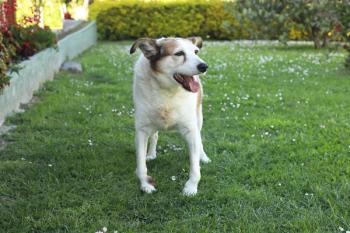
Pain management in large animals: Should we be doing more? (Proceedings)
In 2001, a letter to the editor of Veterinary Record from a highly experienced equine practitioner suggested that horses experience little or no pain after castration and questioned the routine administration of postoperative analgesic medications for all equine castrations.
In 2001, a letter to the editor of Veterinary Record from a highly experienced equine practitioner suggested that horses experience little or no pain after castration and questioned the routine administration of postoperative analgesic medications for all equine castrations. This conclusion was based on the lack of classic behavioral signs of abdominal pain (sweating, rolling, stretching, etc) after castration. Rebuttal letters from other, equally experienced equine practitioners argued eloquently that horses do, indeed, experience significant pain after castration but that pain is manifest in more subtle behavioral alterations. What is the truth? Despite the universality of pain, it is a uniquely personal experience that is difficult or impossible to accurately recognize and quantify. None of us can know the extent to which another individual or animal truly feels pain in any given situation. The neural pathways and higher centers of perception in horses bear enough similarity to those of humans to convince most knowledgeable individuals that the physiology and perception of pain is very similar in our equine patients. However, domestic animal species probably have significantly less ability to appreciate the psychological component of fear of death or "impending doom" that contributes greatly to the emotional response to pain in injured human patients. It is impossible to know to what extent this difference in emotional response impacts the physiological responses to painful stimuli in domestic animals.
It seems intuitive that the pain response must be present in horses as an important evolutionary response to facilitate recognition of potential tissue damage. However, it seems equally intuitive that there has been evolutionary pressure in prey animals to minimize the outward expression (behavioral indicators) of pain and injury. Most equine veterinarians readily recognize signs of acute severe abdominal pain (pawing, rolling, flank gestures, etc.) or injury to the appendicular skeleton (varying degrees of lameness) but our ability to recognize more subtle pain or pain secondary to surgery or trauma is less certain. There is a paucity of objective scientific data regarding recognition and interpretation of pain behaviors in horses. This lack of basic information is compounded by the recognition that the intensity of pain perception and the subsequent behavioral responses after trauma or surgery can vary greatly depending upon genetic and environmental factors. The net result is that the degree of pain perceived by a patient and the extent of behavioral changes exhibited as a result of that perceived pain can vary markedly between individual patients after apparently identical noxious stimuli such as routine castration of a healthy colt.
What is Pain?
The International Association for the Study of Pain has proposed the following definition of pain:
"Pain is an unpleasant sensory and emotional experience associated with actual or potential tissue damage, or described in terms of such damage" and "the inability to communicate in no way negates the possibility that an individual is experiencing pain and is in need of appropriate pain-relieving treatment".
This definition implies that perception of pain is a sensory and emotional event but that the inability to verbalize a response to pain does not negate the experience or the need for therapy. While written in relation to human patients these concepts have equal applicability in veterinary medicine. In 1997, Moloney proposed the following definition for animal pain (Moloney V et al., J An Sci. 1997;75:266-272):
"Animal pain is an aversive, sensory experience representing awareness by the animal of damage or threat to the integrity of its tissues (note that there might not be any damage). It changes the animal's physiology and behaviour to reduce or avoid the damage, to reduce the likelihood of its recurrence and to promote recovery. Non-functional (non-useful) pain occurs when the intensity or duration of the experience is not appropriate for damage sustained (especially if none exists) and when physiological and behavioural responses are unsuccessful in alleviating it."
Pain differs depending on its origin, severity, and the degree and type of tissue damage. It may be classified on the basis of inciting event or purpose of the response (physiologic vs pathologic pain), anatomic location of the painful event (superficial somatic, deep somatic, visceral or neuropathic pain) and duration (acute or chronic).
- Physiologic pain: Occurs when a stimulus that induces minimal or no tissue damage activates high-threshold sensory nerve fibers, warning the organism of potentially tissue damaging events (also known as nociceptive pain).
- Pathologic pain: Occurs when excessively intense or prolonged stimuli induce tissue damage that results in extended discomfort and abnormal sensitivity (also known as clinical pain).
- Somatic pain: Arises from skin, bone, joint, connective tissue, and muscle. This type of pain, especially if superficial, tends to be well-localized and constant. Superficial somatic pain (cutaneous tissues) tends to be sharp, well-localized and constant. It may have a burning or pricking quality. Deep somatic pain (bones, joints, muscles) may more closely resemble visceral pain in being dull or aching in quality.
- Visceral pain: Arises from infiltration, compression, extension or stretching of the thoracic, abdominal or pelvic visceral organs. This type of pain tends to be diffuse, dull, and poorly localized. It may be referred to other deep or cutaneous sites.
- Neuropathic pain: Pain initiated or caused by a primary lesion or dysfunction in the nervous system. It is usually described as burning or tingling pain.
- Acute pain: Pain of short duration typically occurring secondary to surgery or trauma; usually lasts hours to days.
- Chronic pain: Pain persisting longer than the expected time frame for healing or pain associated with progressive, nonmalignant disease (e.g. chronic osteoarthritis); usually pain of greater than one month's duration.
Top Ten Reasons Equine Veterinarians Do Not Provide Adequate Postoperative Analgesia for Their Patients
10. My patients are not experiencing significant pain.
9. I've always done it this way and I've never had a problem.
8. If I eliminate the pain, the horse might overuse that body part and cause more damage.
7. The horse can just tough it out; he'll be fine in a few days.
6. I gave the horse some bute. I don't know what else I can do.
5. These owners can't get oral or IM medication into their horses.
4. The risk of side effects from those drugs (e.g. impaction) are too great.
3. Those drugs might mask a problem like colic if it develops.
2. Those drugs are too expensive and my clients won't pay for it.
1. I just didn't think about it.
How Do We Recognize Pain in Horses?
The varied opinions described above regarding the degree of pain experienced after castration are not unique to British veterinarians. An informal survey of equine veterinarians within the United States asking them to grade the severity of pain after routine castration of a young colt on a scale of 0 (no pain) to 10 (worst possible pain) resulted in scores ranging from 1 to 9. The inability of equine veterinarians to agree on the amount of pain experienced by horses after castration is not surprising if we consider the experiences of small animal veterinarians. For many years, analgesic medications were considered unnecessary after routine spay and neuter surgeries of dogs and cats. In 1997, Hardie et al described behavior after ovariohysterectomy in normal dogs with or without analgesic medication. This work demonstrated that differences in behavior between dogs given analgesics and those given placebo drugs were readily quantifiable but that sometimes subtle changes in behavior were the most reliable indicators of post-operative pain. This work and several similar studies have led the way to a new level of consciousness about the importance of pain management in companion animals. However, the lessons learned have not been readily extended to equine patients.
Pain assessment in small children and animals may be attempted using a variety of subjective behavior assessment instruments. The most simple of these are the visual analog scale and the simple descriptive scale. A visual analog scale requires an observer to score the severity of pain in a patient on a range from 0 (no pain) to 10 or 100 (worst possible pain). The advantage of this type of instrument is its simplicity and internal consistency with a single observer. However, the agreement between untrained observers is often poor, making it difficult to determine trends in degree of pain in a patient that is monitored by multiple care-givers. A simple descriptive scale requires an observer to score pain severity as one of a few levels of severity (e.g. mild, moderate, severe). Numerical rating scales for assessing pain are more complicated than visual analog or simple descriptive scales and may provide a more sensitive technique for assessing pain if appropriately validated prior to use. Several numeric rating scales have been devised for assessment of canine pain. Most of these assign a numerical value to a variety of defined behaviors and the sum of the individual values is defined as the pain score for that patient. A number of studies of small animal pain have used these types of instruments with some success. However, as with visual analog scales, Holton et al found that individual observers were quite consistent in the use of numeric rating scales but inter-observer reproducibility was poor.
What do we know about the behavioral expression of postoperative pain in horses? When equine veterinarians in the United Kingdom were asked how they recognize pain in their patients, the most common answers were evaluation of heart rate and subjective assessment of behavior. It is widely believed among veterinarians and veterinary students that increased heart rate is a reliable indicator of pain in horses. However, studies of postoperative pain in small animals, horses and laboratory animals fail to support this belief. While heart rate increases with severe pain, the variety of other factors that can influence it (hydration status, sepsis, arrhythmia, anxiety, fear) render heart rate unreliable as a sole indicator of pain in most clinical settings.
There are remarkably few reported attempts to develop behavior-based pain scoring systems for horses. Muir suggested a simple visual analog scale in which observers rate pain on a scale of 0 (no pain) to 10 (worst pain) based on available clinical information. This type of pain assessment lends itself easily to inclusion in the medical record as a "fourth vital sign" for every horse which is examined.
A few simple or multidimensional scoring systems for assessing pain after arthroscopic surgery have been described. In 1997, Raekallio et al used a "total post-operative pain severity index" to assess pain after arthroscopic surgery in horses. This TPPSI incorporated simple behavioral observations, a subjective pain score, assessment of degree of lameness, heart rate, and evaluation of stress hormones. The authors concluded that the behavioral assessment provided little useful information over the more subjective pain scoring and more objective physiologic measurements. The poor correlation between their subjective pain score and their attempt at a more objective behavior assessment supports the conclusion that the techniques used did not permit sensitive or reliable evaluation of postoperative pain.
In 2003, Price et al analyzed data from video recordings of horses before and after arthroscopic surgery to identify behaviors suggestive of postoperative pain. There was a wide variation in individual responses and the effect of general anesthesia on postoperative behavior was not assessed. The behaviors that differed most in postoperative horses as compared to presurgical behavior included indicators of restlessness, locomotion and positioning in the stall. These behaviors were more apparent in review of videotapes than in direct behavioral observation for a limited period of time. The authors concluded that evaluation of activity budgets over time may be more useful for assessing pain than short-term direct behavioral observations.
In 2004, Sellon et al used a numerical rating score incorporating direct postural observations (head height, ear position, location in stall, spontaneous locomotor activity) and social interactions with care-givers (response to human, lifting a foot, response to grain) to assess pain after colic surgery. A randomized, placebo-controlled double blind study of horses undergoing exploratory celiotomy for abdominal pain was performed. All horses received flunixin meglumine at standard doses before and after surgery. In addition, horses received either butorphanol as a continuous rate infusion or saline placebo infusion for the first 24 hours after surgery. Horses receiving butorphanol infusions had more normal posture and social behaviors than control horses and the data strongly support the conclusion that postoperative pain may be manifest in horses by behaviors similar to those observed in dogs after ovariohysterectomy. Horses in pain were characterized by lack of locomotion, standing quietly in the back of the stall with head and neck lowered and ears immobile, and exhibiting minimal responses to human intervention. The conclusion that these horses were in significant pain was further supported by observations that butorphanol-treated horses had lower plasma cortisol concentrations than did control horses.
Consequences of Uncontrolled Pain
If horses perceive pain and the neurological pathways for perception and response to pain are similar to those of other mammals, what are the physiologic consequences of pain? Much of the current knowledge of the role that pain plays in overall health and healing after injury or illness arises from investigations into the importance of postoperative pain in the recuperative process after surgical interventions in species other than the horse. Pain responses are an important part of an overall neurohumoral stress response to surgery that is also influenced by anxiety, fluid loss, hemorrhage, endotoxemia, fear or anxiety and infection. The stress response induces neural, endocrine, immune, hematologic and metabolic changes that are intended to restore homeostasis in the patient. Sympathetic activation triggers increases in heart rate and blood pressure and inhibits gastrointestinal motility. Alterations in cortisol, insulin, glucagon and other stress hormones lead to a catabolic state characterized by hyperglycemia, lipolysis, and protein catabolism with resultant weight loss and impaired wound healing. Humoral and cellular immunity are inhibited during the surgical stress response because of sympathetic stimulation, increased cortisol release and endogenous opioid activity. The beneficial effects of decreasing the post-surgical stress response through provision of adequate post-operative analgesia have been extensively documented in human patients. These benefits may include improved wound healing, fewer cardiopulmonary complications (heart attack, thromboembolism), decreased risk of gastrointestinal ileus, decreased hypercoagulability, fewer post-operative infections, less weight loss, and shortened time to discharge from the hospital. Despite evidence of improvement in individual pathophysiologic events, the ultimate effect of analgesic protocols on outcome remains controversial.
There is a dearth of available information regarding the impact of analgesia on postoperative recovery in horses. In 2004, Sellon et al reported the results of a randomized, placebo-controlled double blind study of horses undergoing exploratory celiotomy for abdominal pain. All horses received flunixin meglumine at standard doses before and after surgery. In addition, horses received either butorphanol as a continuous rate infusion or saline placebo infusion for the first 24 hours after surgery. Butorphanol treated horses lost significantly less weight after surgery and were discharged from the hospital earlier than control horses. These findings are consistent with reports of hastened recovery after abdominal surgery if human patients receive adequate postoperative analgesia. Additional equine studies are needed to confirm these results and determine the significance of the role that pain may play in equine patient morbidity and mortality.
Newsletter
From exam room tips to practice management insights, get trusted veterinary news delivered straight to your inbox—subscribe to dvm360.






